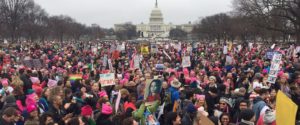 Sources Used for this report: LA Times, Vox.com
Sources Used for this report: LA Times, Vox.com
Crowd estimates from Women’s Marches on Saturday are still trickling in, but political scientists say they think we may have just witnessed the largest day of demonstrations in American history.
According to data collected by Erica Chenoweth at the University of Denver and Jeremy Pressman at the University of Connecticut, marches held in more than 500 US cities were attended by at least 3.3 million people and an additional 1.5 million people rallying in cities in over 75 countries around the world
The march in various cities attracted big celebrities like Madonna, Gloria Steinem, Ashley Judd, Miley Cyrus, Scarlett Johansson, America Ferrera, John Legend and wife Chrissy Teigen
It all started on what, for Teresa Shook, was an unsettling night. It was Nov. 8 and Donald Trump had just won the presidency.
“I went to bed the night of the election just discouraged and woke up feeling worse the next day thinking, ‘How could this be?’ I was just sad and dumbfounded,” Shook told a local TV station .
She decided to do something about it.
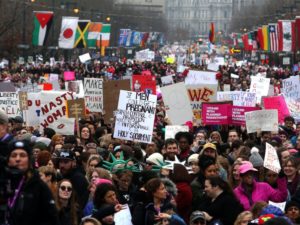 The next night, with some help from friends online, the retired attorney and grandmother living in Hawaii created a Facebook event page calling for a march on Washington after Trump’s inauguration. Before she went to bed, she had about 40 responses. When she woke up, she had more than 10,000.
The next night, with some help from friends online, the retired attorney and grandmother living in Hawaii created a Facebook event page calling for a march on Washington after Trump’s inauguration. Before she went to bed, she had about 40 responses. When she woke up, she had more than 10,000.
On the other side of the country, Bob Bland had the same idea. A New York-based fashion designer who had grown a following after designing “Nasty Woman” and “Bad Hombre” T-shirts, Bland proposed a “Million Pussy March.”
“I think we should build a coalition of ALL marginalized allies + do this,” Bland wrote on Facebook on Nov. 10 . “We will need folks from every state + city to organize their communities locally, who wants to join me?!?”
Bland, working with others, consolidated various protest pages, including Shook’s, that had cropped up on Facebook and recruited three longtime, New York-based activists to be co-chairs of the national march: Tamika Mallory, a gun control advocate; Carmen Perez, head of the Gathering for Justice, a criminal-justice reform group; and Linda Sarsour, who recently led a successful campaign to close New York City public schools on two Muslim holidays.
Shook helped plan a march in Hawaii, but does not have a leadership role on the national level.
Not only did these women bring organizing chops to a rapidly growing movement, they also brought diversity to a campaign that was already being criticized for lacking it.
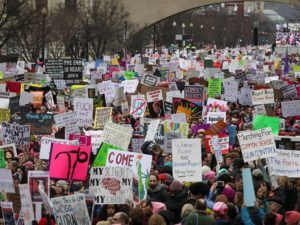 Settling on what to call the march took a few days. “Million Pussy March” perpetuated a slur used by Trump; another early name, “Million Woman March,” seemed too reminiscent of a 1997 protest by African American women of the same name.
Settling on what to call the march took a few days. “Million Pussy March” perpetuated a slur used by Trump; another early name, “Million Woman March,” seemed too reminiscent of a 1997 protest by African American women of the same name.
The organizers eventually adopted the title “Women’s March on Washington,” invoking Martin Luther King Jr.’s civil rights march of 1963. They even got the blessing of King’s daughter Bernice.
The march has become largest inauguration demonstration in history, drawing out 3.5 million people nationwide. Close to 700 sister marches involving 2 million people in 75 cities around the world, according to the Women’s March website.
Donald Trump’s victory over Hillary Clinton came as a shock to many — and for many women who opposed Trump in particular, Clinton’s loss was personally devastating. But after the election, desperation and fear swelled into a plan for action: leading in the “Women’s March on Washington” on January 21, the day after Trump’s inauguration and the first full day of his administration.
What started as a viral idea on social media has snowballed into the biggest mass mobilization yet that America has seen in response to a presidential inauguration. About 60,000 people protested Richard Nixon’s 1973 inauguration at the height of the Vietnam War, and thousands protested George W. Bush’s 2001 inauguration.
The Women’s March has drawn more attendees than the Inauguration itself. More than 400 buses were granted parking permits on Inauguration Day — but about 2,000 buses applied for permits on Saturday, the day of the Women’s March.
The march had some big-name sponsors and partners like Planned Parenthood Federation of America and NARAL Pro-Choice America. Feminist icon Gloria Steinem and actor and civil rights activist Harry Belafonte have signed on as honorary co-chairs. The march had an official permit for an estimated 200,000 marchers to first rally in front of the Capitol at Independence Avenue and Third Street SW, and then march to a park near the White House.
For those who couldn’t make it to Washington on January 21, more than 600 solidarity marches were held in 75 countries. Some rallies in large cities like Boston (where Sen. Elizabeth Warren will speak) are expected to drew hundreds of thousands of attendees.
Although the Women’s March on Washington has been an organic, grassroots effort, it has also been a chaotic one at times. For a while, it seemed doubtful that the march would actually come together in a successful or safe way.
But the huge, spontaneous groundswell behind the march says a lot about this moment in American politics. It’s another sign that Trump could spark a new golden age of activism on the left. And it’s a sobering reminder of why that might be the case: People are genuinely afraid for their civil rights under Trump, and women in particular could have a lot to lose.
Why a women’s march?
Many women were dismayed or even horrified that America chose Trump — an alleged sexual predator whose policies could be a huge setback for women’s health and rights — over Clinton, a highly qualified public servant who could have been America’s first woman president.
This gender dynamic has become such a powerful motivator that the Women’s March will probably become the largest Inauguration Weekend gathering of people who oppose Trump.
Still, organizers insist that the march is not anti-Trump — that instead, it’s an affirmative message to the new administration that “women’s rights are human rights.” The event is being promoted as a “march” or a “rally,” but emphatically not a “protest.”
“Women’s rights are human rights” really shouldn’t be a controversial or politically polarizing statement. But it’s also a famous line from Hillary Clinton’s 1995 speech on women’s issues in Beijing, and it’s pretty obvious that the march is motivated by worries about how women and their rights will be treated under Trump.
Especially for women of color, queer and trans women, and women who belong to other marginalized groups, a Trump presidency could present an existential threat: from a Justice Department that could roll back major civil rights gains, to families being torn apart through mass deportation, to Muslim women feeling too afraid of hateful acts and violence to wear the hijab and freely express their religion, to drastic reductions in access to reproductive health care that would disproportionately harm poor women and women of color.
Was the march just for women?
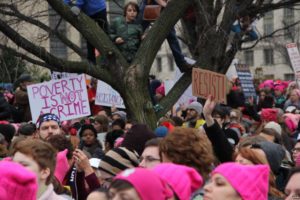 Definitely not. Male allies turned out in large numbers, Bob Bland, one of the first women to organize the march on social media, told the Washington Post.
Definitely not. Male allies turned out in large numbers, Bob Bland, one of the first women to organize the march on social media, told the Washington Post.
But women vastly outnumbered the men at the march — which, for some, actually raised concerns about whether the name of the march made men feel unwelcome:
The march wasn’t for women-only, but it was definitely women-led — a dynamic that some men may not be accustomed to. And the march’s purpose was to rally for women’s issues, not to oppose Trump. (Although, again, it ended up being the largest anti-Trump gathering over Inauguration Weekend, and Trump’s behavior towards women has itself turned out to be a powerful political motivator.)
“We wanted this to be as inclusive as possible while acknowledging that it’s okay to have a women-centered march,” Bland said.
According to the new statement of principles, the march is “a women-led movement bringing together people of all genders, ages, races, cultures, political affiliations and backgrounds.”
The march had faced pushback over diversity issues
Bland and all of the other original organizers were white women, and some attendees were concerned about whether the march would have diverse leadership and take the concerns of women of color into account.
After that, though, three prominent women of color who are experienced activists and organizers joined Bland as national co-chairs of the event: Tamika D. Mallory, Carmen Perez, and Linda Sarsour. Together, the three led a march from New York City to Washington, DC, in 2015 to demand changes in America’s criminal justice system.
Mallory has worked closely with the Obama administration on civil rights and criminal justice issues, and served as the youngest executive director of National Action Network. Perez works on juvenile and criminal justice issues in California and New York and is the executive director of The Gathering for Justice. Sarsour is a Brooklyn-born Palestinian-American Muslim racial justice and civil rights activist, and is the executive director of the Arab American Association of New York.
The original proposed name, the “Million Women March,” was scrapped because there was already a “Million Woman March,” attended by hundreds of thousands of black women, in Philadelphia in 1997.
But there was also some pushback against the current name, the “Women’s March on Washington,” due to concerns that it appropriated the 1963 March on Washington for Jobs and Freedom where Martin Luther King Jr. made his famous “I Have a Dream” speech.
In response to those objections, organizers released a statement calling the march’s current name a “tribute” to the 1963 march — which, they said, “set a precedent” for similar massive marches to demand human rights, including other historic events like the 1965 March on Washington for Peace in Vietnam and the four Marches on Washington for the rights of LGBTQ people in 1979, 1987, 1993 and 2000. Organizers also say they are committed to the six principles of Kingian nonviolence.
Meanwhile, some white women say they feel excluded and attacked by the discussions of race and privilege. One woman, 50-year-old Jennifer Willis, told the New York Times she canceled her trip after reading a post on the march’s national Facebook page, written by a black activist who advised “white allies” to listen more and talk less.
“This is a women’s march,” Willis said. “We’re supposed to be allies in equal pay, marriage, adoption. Why is it now about, ‘White women don’t understand black women’?”
But the march’s organizers did not back down from their intersectional approach — which takes into account the fact that not all groups of women are oppressed in the same ways, and which sees misogyny as interconnected with many other forces that keep women down.
“We believe Gender Justice is Racial Justice is Economic Justice,” the march’s newly-drafted statement of principles reads. “We must create a society in which all women — including Black women, Native women, poor women, immigrant women, Muslim women, lesbian, queer and trans women — are free and able to care for and nurture their families, however they are formed, in safe and healthy environments free from structural impediments.”
The march has a deeply progressive, and explicitly pro-choice, platform
The march’s organizers have assembled a broad, socially inclusive set of principles that represent the caucus of people who are expected to participate, especially women in marginalized groups.
Among other key issues, the march’s statement of principles calls for:
“Accountability and justice for police brutality” and “dismantl[ing] the gender and racial inequities within the criminal justice system”
Freedom from sexual violence
Ratifying the Equal Rights Amendment to the Constitution that would guarantee equal protection based on gender
Affirming that all domestic and caretaking work is work, even if unpaid; and that women — especially women of color — bear the brunt of that burden
“The right to organize and fight for a living minimum wage” for all workers, labor protections for undocumented and migrant workers, and “solidarity with sex workers’ rights movements”
Comprehensive reproductive rights, LGBTQ rights, and immigrant and refugee rights
Given that groups like NARAL and Planned Parenthood sponsor the march, it’s not surprising that the platform calls for “Reproductive Freedom” — defined in part as “open access to safe, legal, affordable abortion and birth control for all people, regardless of income, location or education.”
But some pro-life women were just as disgusted by Trump’s comments as pro-choice women, as Emma Green reported for the Atlantic — and some of them are struggling to find their place in the Women’s March. Some pro-life women plan to join the explicitly pro-choice march because they agree with its other principles; others plan to actively protest the march’s pro-choice message.
One pro-life group, New Wave Feminists, was actually listed as a partner organization in the march for a while. But after the group’s inclusion was noticed by abortion rights supporters and caused controversy, organizers removed New Wave Feminists from the list of partners and said the group’s inclusion had been an error.
It’s a reminder that not everyone who self-identifies as “feminist” supports legal abortion — and that many abortion rights supporters see the term “pro-life feminist” as an oxymoron, since outlawing abortion tends to seriously hurt women’s health and limit their autonomy.
The language about solidarity with sex workers was also changed twice on Tuesday — which exposed another feminist rift and caused some brief controversy.
First, the phrase “sex workers’ rights movements” was deleted and replaced with “all those exploited for sex and labor.” Many advocates for sex workers objected to that change, since it could be read as a suggestion that all sex workers are inherently or equally “exploited.”
Shortly thereafter, however, that language had changed again. The Women’s March now stands “in solidarity with the sex workers’ rights movement,” and also “recognize[s] that exploitation for sex and labor in all forms is a violation of human rights.”
That change may have been an attempt to compromise between two often bitterly divided feminist factions: those who believe that all sex work is inherently exploitative, and those who argue that sex workers deserve the same labor and safety protections as any other workers.
The details
There is a huge list of prominent speakers and musical guests that performed at the rallies — including feminist icon, Madonna, Gloria Steinem, John Legend Planned Parenthood president Cecile Richards, R&B sensation Janelle Monae, and a diverse lineup of prominent activists like Janet Mock, Erika Andiola, and Ai-Jen Poo.
The rally started at 10am on Saturday at the intersection of Independence Avenue and Southwest Third Street, Washington, DC, near the US Capitol.
At 1:15pm, the rally became a march. It will proceed down the National Mall to The Ellipse, a large public park just south of the White House and north of the Washington Monument.

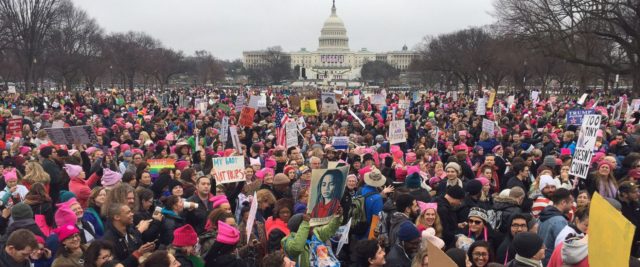
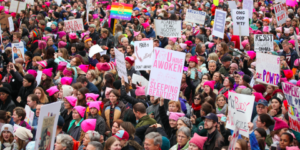






Trump is coming in as President with the lowest approval rating of any U.S. President. This huge show of force by women even compounds his problems. It remains to be seen how Trump- who basically relies on “alternative facts” will interpret this. However- we will sit this out and the mid term elections is only- two years ago!
American women basically told Trump in no uncertain terms that- “their Puxxx is not for grabs”!!
The Donald Trump presidency should be given a chance- like Trump said in a tweet 24 hours ago, The American people have spoken & where were these people when America voted on November 4th
Vive Emperor Trump!
Africa should learn a lot from the power of mass protests that is at the cornerstone of change in American democracy. The suffragette movement-led to women’s voting rights, the civil rights movement led to desegregation and eventually an African American President in Barack Obama, this women’s rights protest will eventually change America and maybe lead to the 1st American female President. Besides the apartheid movement led by the iconic Nelson Mandela, there is no clear example of change in post independence Africa that has been brought by the power of the people.
Am not impressed! The celebrities did absolutely nothing to help Hillary Clinton’s elections chances. In fact they hurt her chances. These women should stay way from the foul mouthed Madonna and her fellow – so called- “A listers”
The Lord will see us through & we shall overcome- someday…
These women should know- that they belong, to the kitchen & the other room fa..
At 45%-Trump is starting with the smallest share of Americans saying they approve of his job performance in Gallup’s poll going back to President Harry Truman. Before Trump George H.W. Bush started with the lowest percent approval, at 51 percent . This Presidency is shaping up to be another Bush disaster
American women have far too many rights & are totally confused. Some do not even know their gender orientation & throw up the sex card every time to intimidate men in America- especially amongst the African Americans- For once, we have a man that can stand up to the excesses of American women- Go Donald, grab away..
This mass rally should be for objective and moral reasons and not for things that push humanity to his early grave. Am impressed with the mass power. Butelet it be directed to promote peace in America and not for ill reasons.
They should please give trump a chance.i believe he’s the change America needs right now